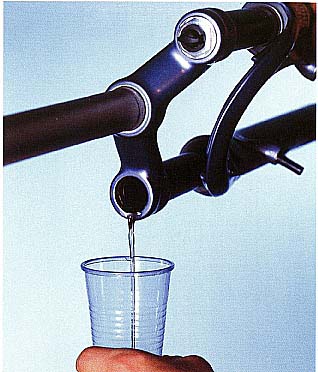Air/oil suspension forks usually have short travel and are popular with cross-country riders. Their spring medium is air, which makes them very light, and their mechanism is damped by oil.
Sometimes they have a negative spring working in the opposite direction of the main air spring. This helps to overcome the stiction (the sticky friction between two adjacent but motionless objects) which is inherent in air/oil suspension forks and is caused by their very tight seals.
Changing oil is necessary from time to time, as dirt in the system starts to cause excessive wear. If you have increased the damping on your fork and its action is still too fast, replacing the oil with a heavier one will slow it down. In the same way, lighter oil can help to speed it up.
- Google listing of all "Suspension, Air, Oil" stuff on our site
- Yahoo! listing of all "Suspension, Air, Oil" stuff on our site
- AltaVista listing of all "Suspension, Air, Oil" stuff on our site
Tools Needed:

Parts of an air/oil suspension fork
Steerer; fork crown; stanchion; Brake boss; Dropout; Air valve; fork brace; slider.

Changing oil
1. Remove the cap from the top of the stanchion without the Schrader air valve. This is the same kind of valve that is used on car tires. You can carry out this following sequence of steps with the fork still in the bike, although it is easier if someone helps you.

2. Pour the old oil out of the stanchion and into a plastic cup. This air/oil fork has an open-bath damping system, in which the damping rod moves up and down an open oil bath. The oil also lubricates the rest of the suspension system.

3. Make sure that you hold the fork blades absolutely vertical.
- Place a bowl under the fork to catch any spills. Carefully pour new oil into the stanchion until it is full and then replace the cap.
- Use a calibrated pouring vessel to ensure that you accurately measure the amount of oil the fork manufacturer specifies.

4. Put the cap back on the oil stanchion, tighten it, and pump up the fork.
- Set the sag again, pumping air in or letting it out to obtain the ideal sag.
- Tighten the Schrader valve if, after setting up the sag correctly, your fork works well at first, then starts to bottom out (the valve may be leaking). Use an automotive valve key.

5. Pump air in or let air out of a fork with negative air springs after you have replaced the oil with one of a different viscosity.
- Adjust the damping of the fork so that it works at the speed you require, then fine-tune its action with the negative spring.
- Pump air in to make the fork more active over small bumps. Let air out to make it less responsive.
